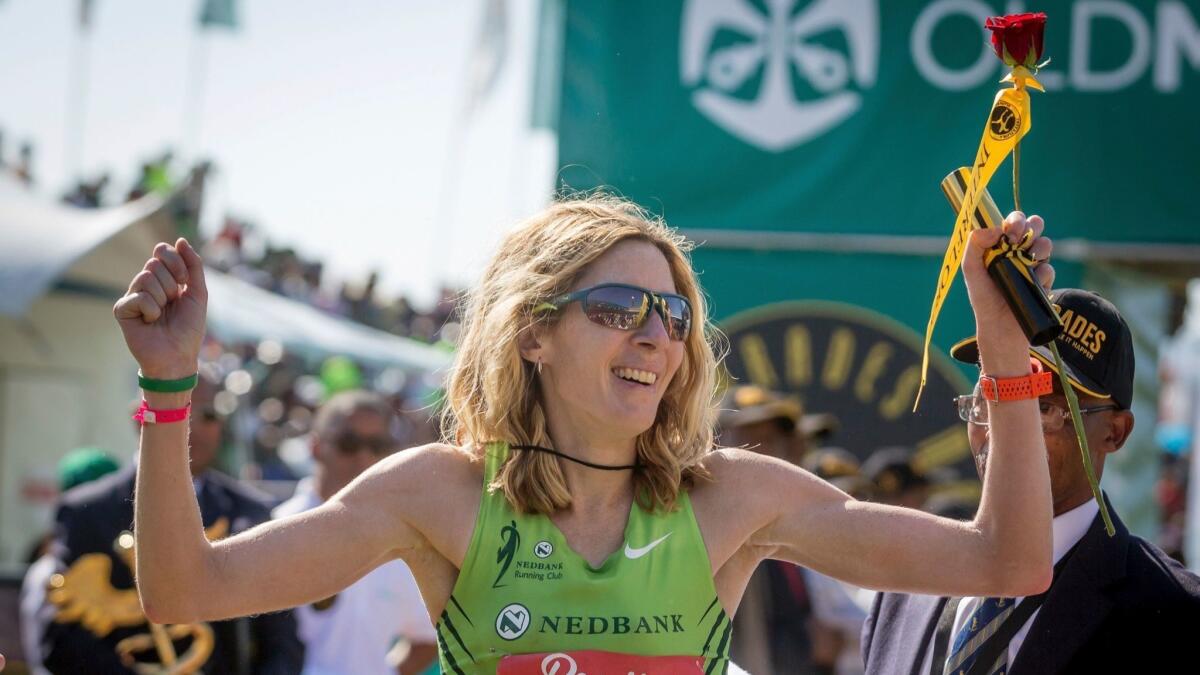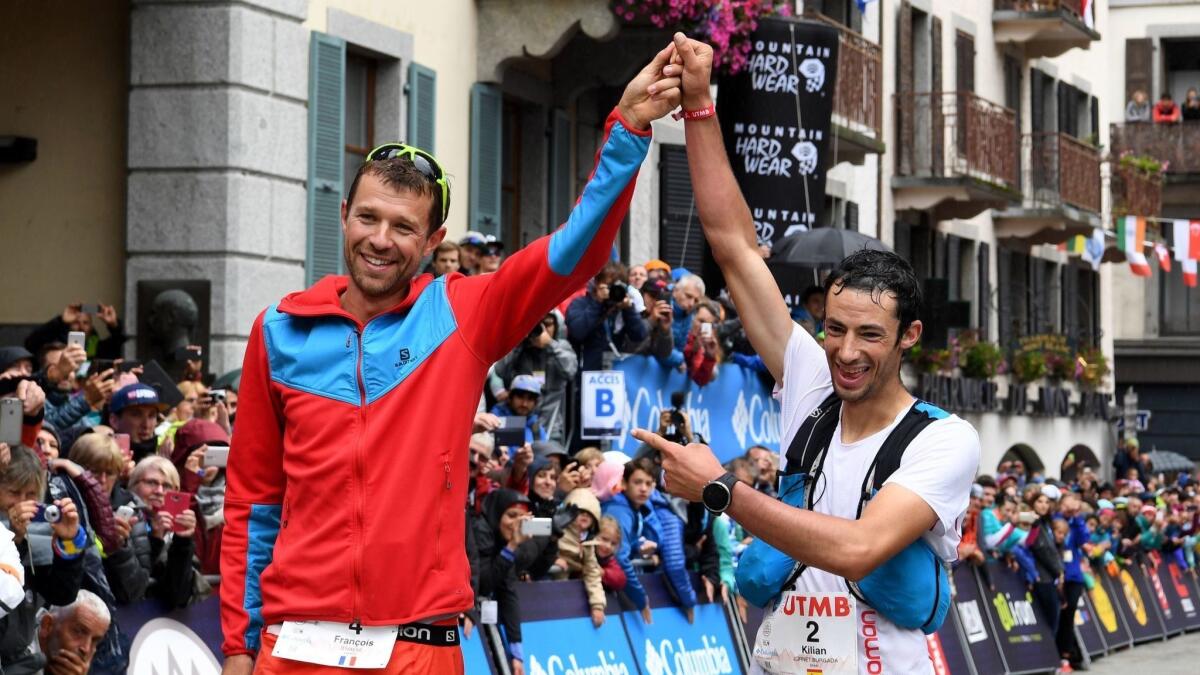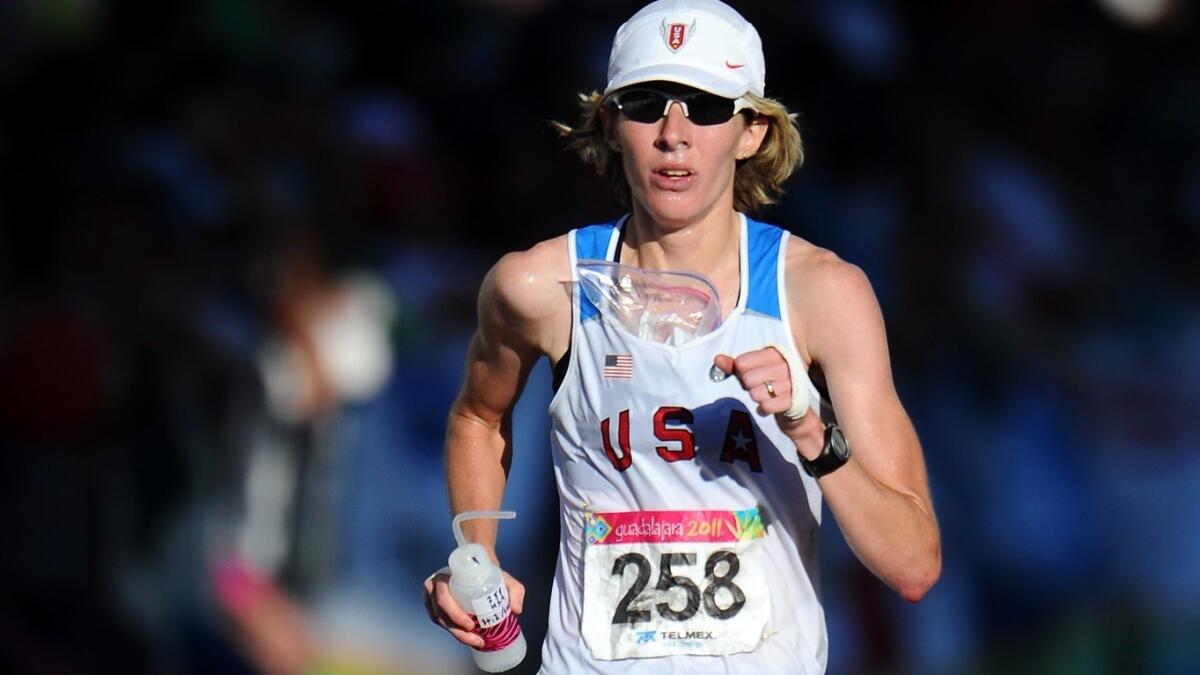Ultra running can mean extreme heat, mountain climbs and, oh yeah, look out for those trees

- Share via
It says something about Camille Herron — and about her peculiar sport — that she finds the story amusing.
The 36-year-old Oklahoman was in a footrace through the Sierra Nevada mountains last summer, a grueling competition that had participants traversing 100 miles of wilderness, pushing through day and night, when she slipped off a path.
“I hit a tree and knocked myself out,” Herron says. Laughter serves as punctuation before she adds: “Sometimes it’s not your day.”
Reaching the finish line is never guaranteed in ultra running, a supercharged version of the marathon in which athletes attempt far-longer distances in often harsh conditions.
One popular ultra race begins in the searing heat of Death Valley and climbs 8,300 feet to the base of Mt. Whitney. Another forces entrants to trudge for nearly three days and nights through the mud and brier of Tennessee mountains.
“I think people are always looking for new challenges,” says Karl Hoagland, publisher of UltraRunning Magazine. “They want something big and epic.”
Though the sport accounts for less than 1% of the U.S. running scene, with races often limited to a few hundred entrants or less, Hoagland says participation has grown almost 20% annually, to more than 150 events nationwide.
On June 23, some of the world’s best ultra runners will congregate in Northern California for the Western States 100-mile Endurance Run, which rates as their Super Bowl. It is also the event where Herron, among the top women competitors, suffered her slip-and-fall last year.
The race has generated buzz because people wonder if she can redeem herself. They will also see a showdown on the men’s side between Jim Walmsley and Francois D’Haene, both of whom are expected to challenge the course record.
As for the other 360 or so entrants, many will simply attempt to survive. As Herron puts it: “Everyone has their reasons for doing this.”

Any course that exceeds the marathon length of 26.2 miles qualifies as an ultra, though many events focus on distances of 50 kilometers, 100 kilometers and 100-plus miles.
Through the 1970s and into the ‘80s, there were only about a half-dozen such races in the U.S. The Western States began as a trail ride for horsemen in the mid-1950s until, in 1974, someone got the idea to try it by foot.
The sport’s growth appears to be part of a historical progression.
First, the running craze of the 1970s triggered a boom in marathons. That led to the popularity of triathlons, which got a boost from being added to the Summer Olympics in 2000.
Hunger for a next level of challenge led some athletes to an even more-strenuous test offered by Western States and the Old Dominion in Virginia and the Wasatch Front, which bills itself as “100 Miles of Heaven and Hell,” in Utah.
“In a world with all the electronic stuff and instant gratification and consumerism, it’s an oasis,” Hoagland says. “It’s a place where you can work hard and feel the pain and reap the rewards.”
Among the scores of ultras now filling the calendar, some make use of long, flat tracks to encourage speed. Others stick to natural terrain.
“Technical races” — the term for rough-hewn courses — can follow established hiking trails or be clearly delineated by brightly colored flags. Or, they might require navigational skills in unmarked territory.
In some of the longer events, runners walk for portions of the 24 to 60 hours. They often carry their own food and water and might even take a “dirt nap” for a few minutes.
Ultra veterans describe a sense of community that blends the solitude of long distances with mutual support.
“I used to run marathons but those are, like, 10,000 people and it’s just a zoo, you’re just a number,” says Ken Hamada of Los Angeles. “The ultras are more personal.”
He adds: “You get a range of runners.”

Frustration, as much as anything, prompted Mauricio Puerto to make the change.
“I always wanted to qualify for the Boston Marathon but was never fast enough,” the 45-year-old Port Hueneme man says. “I got pretty upset at never reaching that goal.”
In 2007, Puerto entered the Hurt 100 in Hawaii, which left him so battered and bruised he couldn’t run for two months. Still, he was hooked.
Ultra races suited an athlete who never quite attained that “runner’s high” until hours into a race. With some adjustments in training, Puerto was amazed at what he could endure.
Once, at the Hardrock 100 in Colorado, he ran for 46 hours nonstop and felt “super great.”
“I know it sounds weird,” he says. “But it’s the way my body works.”
A 2014 study by researchers at Stanford and UC Davis found that while a small percentage of ultra runners incur stress fractures — probably from tromping across uneven ground — they are healthier than the general population and face no greater risk of injury than shorter distance runners.
Within the ultra community, older competitors have fewer health problems than their younger counterparts, perhaps because they are wiser about training and competing.
For many years, the scene was dominated by a 40-plus crowd. Hamada says runners tend to shift to longer distances as they lose the speed of their youth. But the demographic has shifted slightly as a new breed of competitor migrates from track and field.
Herron was an elite marathoner who competed in several U.S. Olympic trials before making the switch.
Among the top men, Walmsley ran cross-country for the U.S. Air Force Academy. Looking for something different after graduation, he was surprised to find ultra runners taking a cautious approach to the first five or so miles.
“Coming from track, once that gun goes off, the race is on,” he says. “If I can run a mile-a-minute faster in the beginning and guys want to give me that head start, I’ll take it.”
This strategy now threatens to revolutionize the sport.
“Walmsley has been busting huge records,” Hoagland says. “He treats ultras like they’re 5Ks.”

When it is suggested that a lot of people would consider running 100 miles insane, Herron responds: “I would say that’s probably right.”
But even within her sport, there are gradations of crazy.
Hamada started his own race in 1986 because he wanted something slightly tougher than the Western States. The Angeles Crest 100 makes use of trails that crisscross the national forest.
Unlike other events where runners must repeat, say, a 20-mile loop, his course stretches from point-to-point. What makes it tougher? Mountainous climbs in the final 30 miles.
“You put the challenging hills at the end,” he says. “That’s when your tank is empty.”
Typically, only 60% to 70% of the people who enter the AC100, which will take place in early August this year, reach the finish line. The success rate can be lower in other races.
Blistering temperatures distinguish the Badwater 135 in Death Valley. The Hardrock 100 bills itself as a “graduate level” challenge because of its Rocky Mountains elevation and about 33,000 feet in accumulated climbs. Wilderness navigation and survival skills are a must.
But when runners talk about the toughest course, they often mention something else.
The Barkley Marathons trace their history back to 1977, when a group of inmates — including James Earl Ray, who assassinated Martin Luther King Jr. — escaped from the Brushy Mountain State Penitentiary in eastern Tennessee.
Thwarted by hostile terrain, the convicts did not get far before being recaptured a few days later. A long-distance runner named Gary Cantrell, who lived in the area, figured he could have covered at least 100 miles in that time.
The race he created years later selects only about 40 runners from hundreds of applicants each spring. There are no manned checkpoints or aid stations as competitors bull through mud, brush and 60,000 feet of climbs.
In some 30 years, only 15 people have completed the 100-mile course within the 60-hour time limit.
As three-time finisher Jared Campbell writes on the Barkley web site: “On the final lap 5, due to some extreme foot pain (skin) and sleep deprivation I experienced an incredible distillation of my physical and mental self down to a few basic senses and thoughts, which was both an educational and beautiful experience.”
A different sort of inspiration struck Aaron Sorensen after his attempt at the Barkley.
Though the physical challenge of the race appealed to him, the Southern California man did not like charting each step with a topographical map provided shortly before the start.
“I’d rather have it tough against the course, not tough finding stuff,” Sorensen says.
So he created the Baldy Marathons, which begin and end at the Mount Baldy ski resort. With five laps of a 20-mile loop featuring 50,000 feet in vertical gain, the biannual event is not so much a run as a crawl.
Only 30 or so people have shown up for each of the first five races, with three completing 100 kilometers and none finishing 100 miles in the 60-hour limit.
“The course is about as chewed-up and messed-up as it can be,” Sorensen says. “The hardest part is going downhill because the footing is crappy. If you get hurt, you’re done.”
New races popping up around the country, more and more people wanting join in — all of that should be good news for ultra running. Still, some within the community wonder.
In the old days, Hamada says, the same 50 to 200 hardy souls reconvened at every race.
“You would see the same faces all the time,” he says. “There was always a lot of camaraderie.”
Fast runners stopped to help slower ones who slipped on the trail. Winners lingered at the finish line for hours to cheer on the stragglers.
“Kindred spirits,” Hoagland says. “Everybody is dealing with the same thing.”
The publisher worries about hyper-competitiveness overshadowing a traditional bond forged by equal parts suffering and triumph. He wants to see runners competing with each other instead of against each other.
As the Western States draws near, Walmsley sounds like a fighter when discussing his face-off against D’Haene; they ran neck-and-neck for 70 miles before the Frenchman pulled away to win the UTMB race in Europe.
“I know I’ve got to bring my ‘A’ game,” he says.
There is additional incentive to go fast, given that Walmsley’s first two Western States ended in disappointment. In 2016, he led late in the race but took a wrong turn.
Yet winning and losing are only part of his motivation. He talks about training with friends on trails around his home in northern Arizona. On solo runs, he says, “you can stop and enjoy the view and feel the breeze.”
Ultra running has a similar, personal meaning for Herron.
It makes sense to her that outsiders might view the sport as extreme. Only a few years ago, she figured anything beyond a marathon had to be harmful to the body.
Now, she approaches the physical ordeal of 100-milers with a sense of curiosity, as if it were one of the science projects in her day job as a medical research assistant.
“It’s kind of scary but also really exciting,” she says. “Every time I’ve made the leap to run farther, I’ve been surprised to see how far, how fast I can go.”
So long as she avoids the trees.
Follow @LAtimesWharton on Twitter
Go beyond the scoreboard
Get the latest on L.A.'s teams in the daily Sports Report newsletter.
You may occasionally receive promotional content from the Los Angeles Times.








